-
ORIGINAL ARTICLE11-29-2022
Outlining the therapeutic itineraries of children with disabilities in the professional health care subsystem
Revista Brasileira de Enfermagem. 2022;75(3):e20210169
Abstract
ORIGINAL ARTICLEOutlining the therapeutic itineraries of children with disabilities in the professional health care subsystem
Revista Brasileira de Enfermagem. 2022;75(3):e20210169
DOI 10.1590/0034-7167-2021-0169
Views0See moreABSTRACT
Objectives:
to identify the outlining of therapeutic itineraries of families of children with disabilities in the professional health care subsystem.
Methods:
qualitative research carried out in two specialized services in the state of Ceará, with 41 family members interviewed using the life path technique and reports submitted to descending hierarchical classification and similitude analysis, with the help of the IRaMuTeQ software and the theoretical framework of health care systems.
Results:
the classes described the families’ itineraries in five paths, related to faith, support structures, medical behaviors, professionals, and health services. The professional subsystem stood out as deficient in outlining the therapeutic itinerary for access to health care for children with disabilities, without promoting integration between services in the Care Network.
Final considerations:
the families’ therapeutic itineraries showed homogeneous discourse with themes related to the care of professionals and spiritual aspects.
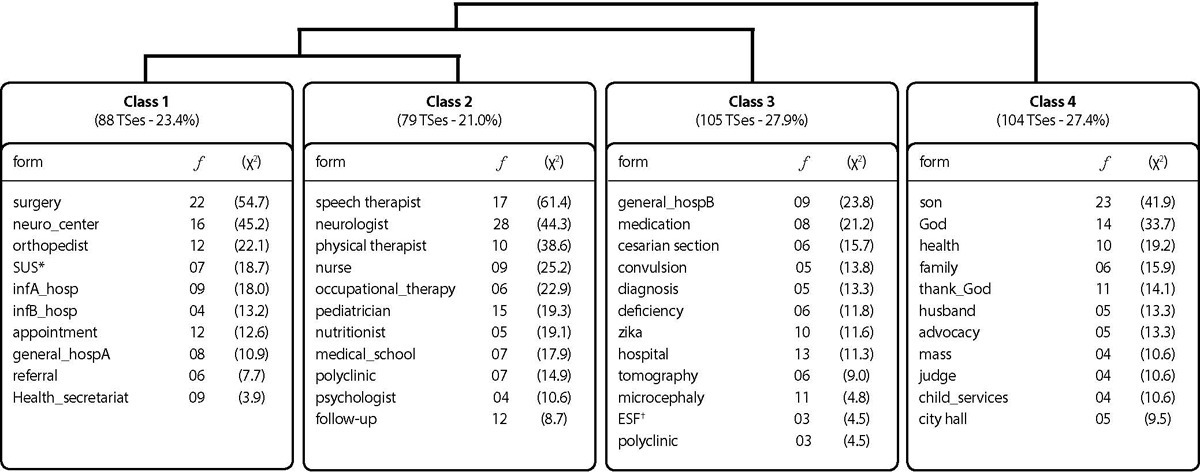
-
ORIGINAL ARTICLE11-29-2022
Undernutrition and associated factors in primary schoolchildren in Lokossa, Benin: a cross-sectional study
Revista Brasileira de Enfermagem. 2022;75(3):e20210254
Abstract
ORIGINAL ARTICLEUndernutrition and associated factors in primary schoolchildren in Lokossa, Benin: a cross-sectional study
Revista Brasileira de Enfermagem. 2022;75(3):e20210254
DOI 10.1590/0034-7167-2021-0254
Views1See moreABSTRACT
Objectives:
to estimate the prevalence of stunting and thinness and sociodemographic, household, family, dietary, and scholar associated factors in schoolchildren living in Lokossa-Benin.
Methods:
a survey conducted in a probabilistic sample (n=615) of primary schoolchildren (8-17 years), from 12/2018 to 01/2019, using structured questionnaire and 24-hour dietary recall. Thinness and stunting were defined as Height-for-age and Body Mass Index-for-age below-2 standard deviations, respectively. Associations were estimated by chi-square test and logistic regression.
Results:
thinness and stunting prevalence was 13.1% (95%CI:9.0-18.7) and 25.5% (95%CI:20.6-31.2), respectively. Odds of thinness were higher among older schoolchildren and those who experienced hunger at school. Odds of stunting increased with age, low diet diversity, experiencing hunger at school, and having school meal five days a week (OR:2.09; 95%CI:1.29-3.36).
Conclusions:
stunting was the most common problem. Older schoolchildren and those with food deprivation or poor diet diversity were the most affected.
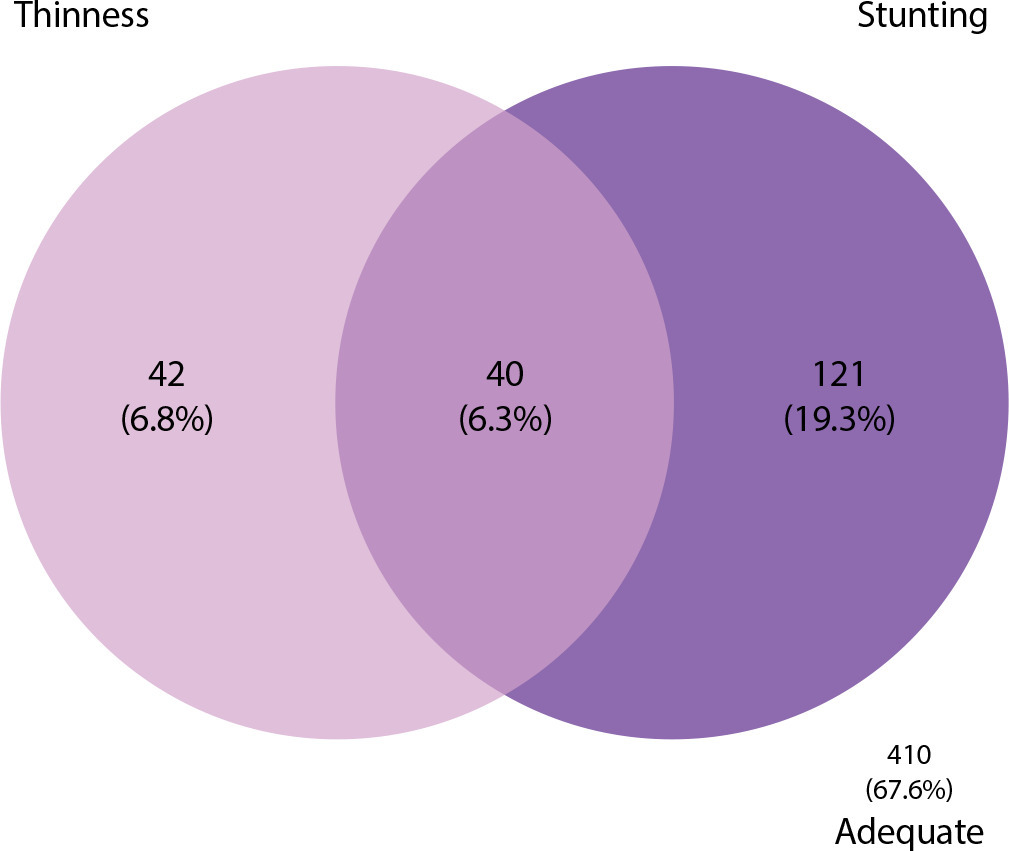
-
ORIGINAL ARTICLE11-29-2022
Factors associated with bronchopulmonary aspiration: a national-based study
Revista Brasileira de Enfermagem. 2022;75(3):e20210220
Abstract
ORIGINAL ARTICLEFactors associated with bronchopulmonary aspiration: a national-based study
Revista Brasileira de Enfermagem. 2022;75(3):e20210220
DOI 10.1590/0034-7167-2021-0220
Views0See moreABSTRACT
Objectives:
to determine the prevalence of bronchopulmonary aspiration in the Brazilian scenario, the factors associated with the incident and the variables associated with death.
Methods:
a cross-sectional and analytical study, carried out from analysis of notifications of incidents related to bronchopulmonary aspiration of the Health Surveillance Notification System, from January 2014 to December 2018.
Results:
of the 264,590 notifications, 553 referred to aspiration, whose prevalence rate was 0.21%. There was an association between the event and age, ethnicity, main medical diagnosis, country region, service type, health unit and consequences for patients. Furthermore, four independent predictor variables for death were found: living in the North or South regions, being elderly and receiving healthcare at night.
Conclusions:
the prevalence rate of bronchopulmonary aspiration was small, but with a negative impact on patients.
-
ORIGINAL ARTICLE11-29-2022
Professional burnout of nursing team working to fight the new coronavirus pandemic
Revista Brasileira de Enfermagem. 2022;75:e20210498
Abstract
ORIGINAL ARTICLEProfessional burnout of nursing team working to fight the new coronavirus pandemic
Revista Brasileira de Enfermagem. 2022;75:e20210498
DOI 10.1590/0034-7167-2021-0498
Views0See moreABSTRACT
Objective:
to identify burnout and associated factors among nursing workers working in coping with COVID-19.
Methods:
a cross-sectional study, developed in four hospitals in a capital in southern Brazil. Sample (n=499) composed of nurses and nursing technicians/assistants, who answered an online form containing socio-occupational characterization and the Maslach Burnout Inventory. Descriptive and inferential statistical analysis was performed, including multiple comparison tests.
Results:
burnout was identified in 60 (12%) workers, with no significant difference between hospitals, but with a difference in dimensions between them. In the emotional exhaustion dimension, a higher proportion (52.9%) was found at a moderate level. Prevalence of high level of professional achievement of 95.4% was identified.
Conclusion:
the presence of burnout was significantly prevalent among nurses and females. It reinforces the need to develop strategies to promote the health of nursing workers, providing improvement in health services and reduction of care and labor risks.
-
ORIGINAL ARTICLE11-29-2022
Changes implemented in the work environment of nurses in the COVID-19 pandemic
Revista Brasileira de Enfermagem. 2022;75:e20201381
Abstract
ORIGINAL ARTICLEChanges implemented in the work environment of nurses in the COVID-19 pandemic
Revista Brasileira de Enfermagem. 2022;75:e20201381
DOI 10.1590/0034-7167-2020-1381
Views0See moreABSTRACT
Objective:
to describe the changes implemented in the work environment of nurses in university hospitals considering the COVID-19 pandemic.
Methods:
this qualitative and descriptive research was developed from an online survey with 75 nurses from three Brazilian university hospitals. Data processing occurred through textual analysis with the aid of software IRAMUTEQ.
Results:
five semantic classes were obtained: Organization of units for exclusive care of patients with COVID-19; Adaptations in the use of personal protective equipment; Physical structure adaptation; Care flow institution; Increased number of beds and training courses. Final considerations: the results show the effort of healthcare and nursing professionals/managers in the development of structural adaptations and reorganizations of care processes, in the hospital context, to respond with quality and efficiency to the demands arising from the COVID-19 pandemic.
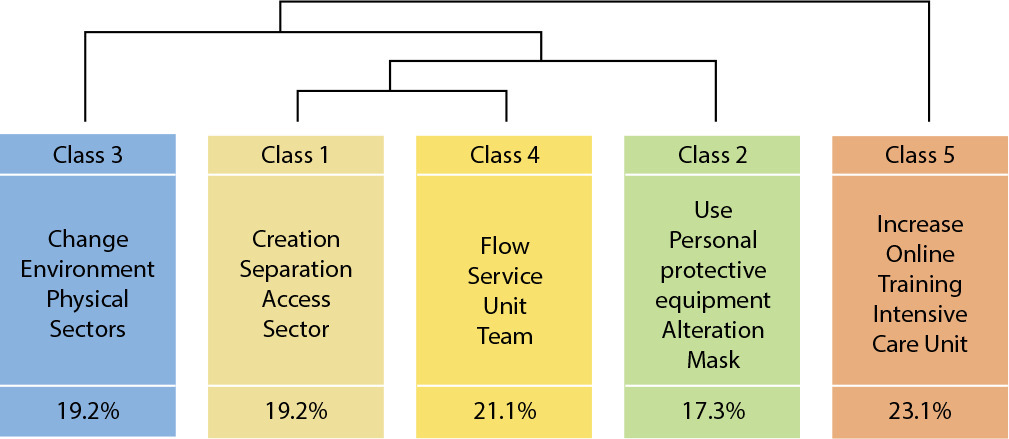
-
EXPERIENCE REPORT11-29-2022
Virtualization of the Brazilian Nursing Week in the COVID-19 pandemic: the novelty and the tangible
Revista Brasileira de Enfermagem. 2022;75:e20201203
Abstract
EXPERIENCE REPORTVirtualization of the Brazilian Nursing Week in the COVID-19 pandemic: the novelty and the tangible
Revista Brasileira de Enfermagem. 2022;75:e20201203
DOI 10.1590/0034-7167-2020-1203
Views0See moreABSTRACT
Objective:
to report the virtualization experience of the 81st Brazilian Nursing Week of a public university in the state of Rio de Janeiro.
Methods:
an experience report with descriptive approach on the planning and virtual operationalization of a traditional nursing event, which took place in May 2020.
Results:
the event had 543 entries and 39 activities were offered, 3 panels with the presence of international guests, 1 national conference, 3 thematic roundtable discussions, 9 roundtable discussions involving projects and extension leagues, 5 cultural activities and 17 activities in social networks (lives and videos). Final considerations: the virtualization of the 81st Brazilian Nursing Week brought the learning and appropriation of new ways of debating nursing in times of physical isolation, which will contribute to an immediate future in social and work relations as well as to the collaborative construction of knowledge.
-
ORIGINAL ARTICLE11-29-2022
Reflections on nursing and COVID-19 in light of health education
Revista Brasileira de Enfermagem. 2022;75:e20201305
Abstract
ORIGINAL ARTICLEReflections on nursing and COVID-19 in light of health education
Revista Brasileira de Enfermagem. 2022;75:e20201305
DOI 10.1590/0034-7167-2020-1305
Views0See moreABSTRACT
Objective:
To reflect on the nursing and pandemic of COVID-19 considering health education, health promotion, and the Ottawa Charter action areas.
Methods:
A theoretical-reflexive study on health education and health promotion concepts and the areas of action presented in the Ottawa Charter.
Results:
Educational actions are present in the contexts of epidemics and pandemics, as well as in the work of nurses, who need to be increasingly based on dialogue and individual and collective empowerment to enable users to adopt healthy and preventive behaviors – in this case, concerning COVID19. However, this professional needs effective and efficient public policy actions and measures based on scientific assumptions of health promotion. Final considerations: The actions of health education need to be increasingly valued because knowledge can be considered the first “vaccine” to combat any pandemic.

-
ORIGINAL ARTICLE11-26-2022
Factors associated with suicide ideation of healthcare university students
Revista Brasileira de Enfermagem. 2022;75:e20200982
Abstract
ORIGINAL ARTICLEFactors associated with suicide ideation of healthcare university students
Revista Brasileira de Enfermagem. 2022;75:e20200982
DOI 10.1590/0034-7167-2020-0982
Views0See moreABSTRACT
Objectives:
to analyze the factors associated with suicidal ideation in students from healthcare graduation courses.
Methods:
quantitative, cross-sectional study, with 251 students from the courses of radiology, speech-language therapy, medicine, nutrition, health service management, and nursing, from a federal higher education institution in the Southeast of Brazil. Data were collected from August to October 2019, using an electronic questionnaire.
Results:
the prevalence of suicidal ideation among participants was 26.33%. In the final logistic regression model, only depressive symptoms were associated with suicidal ideation. Having symptoms of depression increased the chances of suicidal ideation 2.6 times.
Conclusion:
the high prevalence of suicidal ideation and its associated factors constitutes a situational diagnosis that demands the elaboration of public and institutional policies, focused on the promotion and attention to the mental health of the students.
-
REVIEW06-10-2022
Self-inflicted violence and suicide in people living with HIV/AIDS: a systematic review
Revista Brasileira de Enfermagem. 2022;75:e20210768
Abstract
REVIEWSelf-inflicted violence and suicide in people living with HIV/AIDS: a systematic review
Revista Brasileira de Enfermagem. 2022;75:e20210768
DOI 10.1590/0034-7167-2021-0768
Views0See moreABSTRACT
Objectives:
to analyze intellectual productions on self-inflicted violence and suicide in people living with HIV/AIDS.
Methods:
a systematic review, carried out between March and April 2021, in the PubMed®/MEDLINE®, Web of Science and LILACS databases, subsidized in the Strengthening the Reporting of Observational Studies in Epidemiology. The period outlined was from 2011 to 2020.
Results:
a total of 199 studies were identified, and 16 composed the final sample, grouped into the categories: Sociodemographic characteristics of victims of self-inflicted violence/suicide and their intervening factors (pointing to young adults, especially homosexuals, with low social support and a history of mental illness or substance abuse as usual victims); Successful measures for suicide prevention/control in people living with HIV/AIDS (suggesting more frequent psychosocial and clinical follow-up of those starting antiretroviral and immunocompromised treatment).
Conclusions:
biopsychosocial follow-up, analysis of sociodemographic profile and intervening factors should be frequent in this population for disease prevention/control.

-
ORIGINAL ARTICLE09-05-2022
Screening for common mental disorder in elderly residents in the countryside: a cross-sectional study
Revista Brasileira de Enfermagem. 2022;75:e20210875
Abstract
ORIGINAL ARTICLEScreening for common mental disorder in elderly residents in the countryside: a cross-sectional study
Revista Brasileira de Enfermagem. 2022;75:e20210875
DOI 10.1590/0034-7167-2021-0875
Views0See moreABSTRACT
Objective:
To estimate the prevalence of common mental disorders and their associated factors in the elderly in a municipality in the countryside of the Brazilian Midwest.
Methods:
Quantitative, observational, cross-sectional approach research, conducted with 218 elderly people.
Results:
The prevalence of the common mental disorder among the elderly was 25.1%; in the univariate analysis, it was higher in females (35.4%), in the age group of 80 years or older (46.1%), brown skin color (30.2%), widowed (42.6%), illiterate (47.6%), and retired (27.6%). In the multiple analysis, the variables female gender (p<0.006), age 80 years or older (p<0.036), dissatisfaction with life (p<0.009), lack of social interaction (p=0.017), and dysfunctional family (p=0.021) remained associated with CMD.
Conclusion:
The results revealed are helpful and contribute to the reinforcement of the need for mental health care in this population extract so growing worldwide.
-
ORIGINAL ARTICLE06-03-2022
Association between falls in older adults and prevention group
Revista Brasileira de Enfermagem. 2022;75:e20200207
Abstract
ORIGINAL ARTICLEAssociation between falls in older adults and prevention group
Revista Brasileira de Enfermagem. 2022;75:e20200207
DOI 10.1590/0034-7167-2020-0207
Views0See moreABSTRACT
Objectives:
to assess the effectiveness of guidelines on fall prevention in a group of older adults in Primary Health Care.
Methods:
a cross-sectional study, carried out with older adults selected by a simple random sample (274; N=1,234). Data covered sociodemographic and socioeconomic variables, marital status, health conditions, factors associated with falls and participation in the prevention group. Student’s t test was used, and dichotomous variables were used by the chi-square test. The project met ethical requirements.
Results:
sample with female profile (61.7%), married, with low education, mean age of 71.69 years. The factors associated with falls identified were female sex, medicalization and participation in the prevention group. There was no protective association between participation in a fall prevention group in older adults and a decrease in the number of falls.
Conclusions:
based on evidence, a personalized intervention during the nursing visit is suggested as a strategy to prevent falls.

-
ORIGINAL ARTICLE03-07-2022
Predictors of frailty in older people users of Primary Health Care
Revista Brasileira de Enfermagem. 2022;75:e20201292
Abstract
ORIGINAL ARTICLEPredictors of frailty in older people users of Primary Health Care
Revista Brasileira de Enfermagem. 2022;75:e20201292
DOI 10.1590/0034-7167-2020-1292
Views0See moreABSTRACT
Objective:
to identify the prevalence and predictors of frailty in older people in Primary Health Care.
Method:
this is a descriptive and correlational study, carried out in a convenience sample of 136 older people in the community. Data were collected through a sociodemographic and clinical questionnaire and frailty phenotype. Student’s t test or U-Mann-Whitney test, chi-square and binary logistic regression were used for data analysis.
Results:
the prevalence of frailty was 26.5% (n=36). Frail individuals had older age (p=0.011), worse self-rated health (p=0.001) and lower physical capacity (p<0.001). In the multivariable regression, it was observed that frail individuals had older age (Odds Ratio=1.111; 95% confidence interval=1.026-1.203) and worse physical capacity (Odds Ratio=0.673; 95% confidence interval=0.508-0.893).
Conclusions:
the prevalence of frailty in older people in Primary Health Care was considerable. Advanced age and worse physical capacity were the most relevant predictors of frailty in the elderly.
-
ORIGINAL ARTICLE04-15-2022
Validation of Questionnaire to Assess the Impact of Dementia on the Family
Revista Brasileira de Enfermagem. 2022;75:e20210232
Abstract
ORIGINAL ARTICLEValidation of Questionnaire to Assess the Impact of Dementia on the Family
Revista Brasileira de Enfermagem. 2022;75:e20210232
DOI 10.1590/0034-7167-2021-0232
Views0See moreABSTRACT
Objective:
To validate a questionnaire to assess the impact of dementia on one of the household members.
Methods:
Methodological study. The instrument was designed based on literature review, expert opinion, and researchers’ experience and then applied to a non-probability convenience sample consisting of 262 family members who live daily with a person with dementia. The construct validity was studied by exploratory factor analysis, principal components method, with varimax rotation of the items.
Results:
An instrument with 30 items was obtained, distributed in four dimensions: “Emotional dimension,” “Economic dimension,” “Family relations dimension,” and “Support-seeking dimension.” Factor analysis revealed a total explained variance of 54.96% and a total Cronbach’s alpha of .899.
Conclusions:
The instrument presents high internal consistency, grouped into four dimensions, all closely related to the family’s adaptation to the onset of dementia in one of its members.
-
ORIGINAL ARTICLE03-07-2022
Is self-esteem associated with the elderly person’s quality of life?
Revista Brasileira de Enfermagem. 2022;75:e20210388
Abstract
ORIGINAL ARTICLEIs self-esteem associated with the elderly person’s quality of life?
Revista Brasileira de Enfermagem. 2022;75:e20210388
DOI 10.1590/0034-7167-2021-0388
Views0See moreABSTRACT
Objective:
To analyze the association between self-esteem and quality of life in the elderly.
Methods:
Cross-sectional web survey developed with 519 elderly people. Participants filled out three data collection instruments developed on the Google Forms platform and widely disseminated through all of Brazil. Fisher’s exact test, Mann-Whitney, Pearson correlation, and linear regression with 95% confidence interval were used.
Results:
Self-esteem was associated with all quality-of-life facets: sensory skills [β= 1.307; p<0.001]; autonomy [β= 2.101; p<0.001]; past, present, and future activities [β= 2.486; p<0.001]; social presence [β= 2.547; p<0.001]; death and dying [β= 2.175; p<0.001]; and intimacy [β=2.378; p<0.001].
Conclusion:
There is a positive and statistically significant association between self-esteem and quality of life in the elderly. We therefore suggest the development of local policies capable of raising this age groups’ self-esteem and reaffirming aging as a new possibility for discoveries and pleasure.
-
EXPERIENCE REPORT10-24-2022
Nursing process for elderly women susceptible to falls from the perspective of the Pender’s Model
Revista Brasileira de Enfermagem. 2022;75:e20210913
Abstract
EXPERIENCE REPORTNursing process for elderly women susceptible to falls from the perspective of the Pender’s Model
Revista Brasileira de Enfermagem. 2022;75:e20210913
DOI 10.1590/0034-7167-2021-0913
Views0See moreABSTRACT
Objectives:
to describe the strategy of applying the nursing process guided by Pender’s Health Promotion Model to elderly women susceptible to falls with a view to promoting a self-efficacy behavior for fall prevention.
Methods:
application of the nursing process to eleven elderly women who had already experienced falls, living in a neighborhood in the outskirts of Belem, state of Pará, which involved interviews to obtain their nursing history and group meetings using the focus group technique to develop the other phases of the nursing process: nursing diagnosis, nursing interventions, and nursing assessment.
Results:
despite the risk factors for falls, the intervention model adopted in this study allowed elderly women to enhance their self-efficacy.
Final Considerations:
the model proved to be suitable for the participation of elderly women in actions to build fall prevention behaviors, with a view to healthier lifestyles.

-
ORIGINAL ARTICLE10-24-2022
Factors associated with symptoms of physical and emotional burden in informal caregivers of the elderly
Revista Brasileira de Enfermagem. 2022;75:e20210927
Abstract
ORIGINAL ARTICLEFactors associated with symptoms of physical and emotional burden in informal caregivers of the elderly
Revista Brasileira de Enfermagem. 2022;75:e20210927
DOI 10.1590/0034-7167-2021-0927
Views1See moreABSTRACT
Objectives:
to analyze the personal and work-related burden factors associated with physical and emotional symptoms of informal caregivers of the elderly.
Methods:
cross-sectional study conducted with 121 informal caregivers and 121 seniors who received care, assessed individually for the risk of: physical overload, musculoskeletal symptoms, Self-Reporting Questionnaire, effort perception, and Katz index.
Results:
a greater perception of effort raises up to 3.3 times the chances of presenting symptoms of pain in the spine region (p=0.01), and lower functional capacity of the elderly increases up to 1.3 times the chances of presenting pain symptoms in the spine region (p=0.02). The symptoms of emotional overload were associated with the caregiver’s low income (p=0.02).
Conclusions:
the perception of effort, dependence of the elderly, caregiver’s age, and symptoms of emotional overload are involved with caregivers’ symptoms of physical overload, and low income, with emotional overload.
-
ORIGINAL ARTICLE07-31-2020
Social and obstetric inequalities and vaccination in pregnant women
Revista Brasileira de Enfermagem. 2020;73:e20190099
Abstract
ORIGINAL ARTICLESocial and obstetric inequalities and vaccination in pregnant women
Revista Brasileira de Enfermagem. 2020;73:e20190099
DOI 10.1590/0034-7167-2019-0099
Views0See moreABSTRACT
Objectives:
to analyze the association of socioeconomic level and obstetric characteristics with vaccine registration of pregnant women.
Methods:
cross-sectional study, performed with 480 women in puerperal. Vaccination of pregnant women was considered a dependent variable and as independent variables were age, skin color, education, steady union, paid work, and number of prenatal consultations. Association between variables was verified by the Poisson’s regression model.
Results:
from 480 pregnant women’s health cards, 10.63% had information on hepatitis B vaccination; 31.46% for tetanus; and 90% of the health cards had not register for influenza. There was an association of paid work and number of prenatal consultations with hepatitis B vaccination.
Conclusions:
lower percentages in absence of vaccination occurred in women who were in the job market and had a higher number of prenatal consultations. This suggests that socioeconomic inequalities may interfere with the vaccination of pregnant women in health services.
-
REVIEW02-10-2020
Low Chronic Self-Esteem and Low Situational Self-Esteem: a literature review
Revista Brasileira de Enfermagem. 2020;73(1):e20180004
Abstract
REVIEWLow Chronic Self-Esteem and Low Situational Self-Esteem: a literature review
Revista Brasileira de Enfermagem. 2020;73(1):e20180004
DOI 10.1590/0034-7167-2018-0004
Views0See moreABSTRACT
Objective:
to develop a literature review about low self-esteem and components of the nursing diagnoses Low Chronic Self-Esteem and Low Situational Self-Esteem in patients with depressed mood.
Method:
an integrative literature review carried out in the Pubmed portal and in the Scopus and Web of Science electronic bibliographic databases. Depression and self-esteem descriptors were used, resulting in 32 articles.
Results:
literature indicated 7 clinical indicators and 14 etiological factors for low self-esteem.
Conclusion:
The clinical indicators Suicidal ideation and Ineffective treatment were more prevalent in the study. The etiological factors Stressful events and Stigmatization were the most frequent, both of which were suggested as new related factors for low self-esteem. Nursing diagnosis recognition can contribute to intervention strategy elaboration by the nurse, according to the urgent diagnostic and the individual’s particularities.
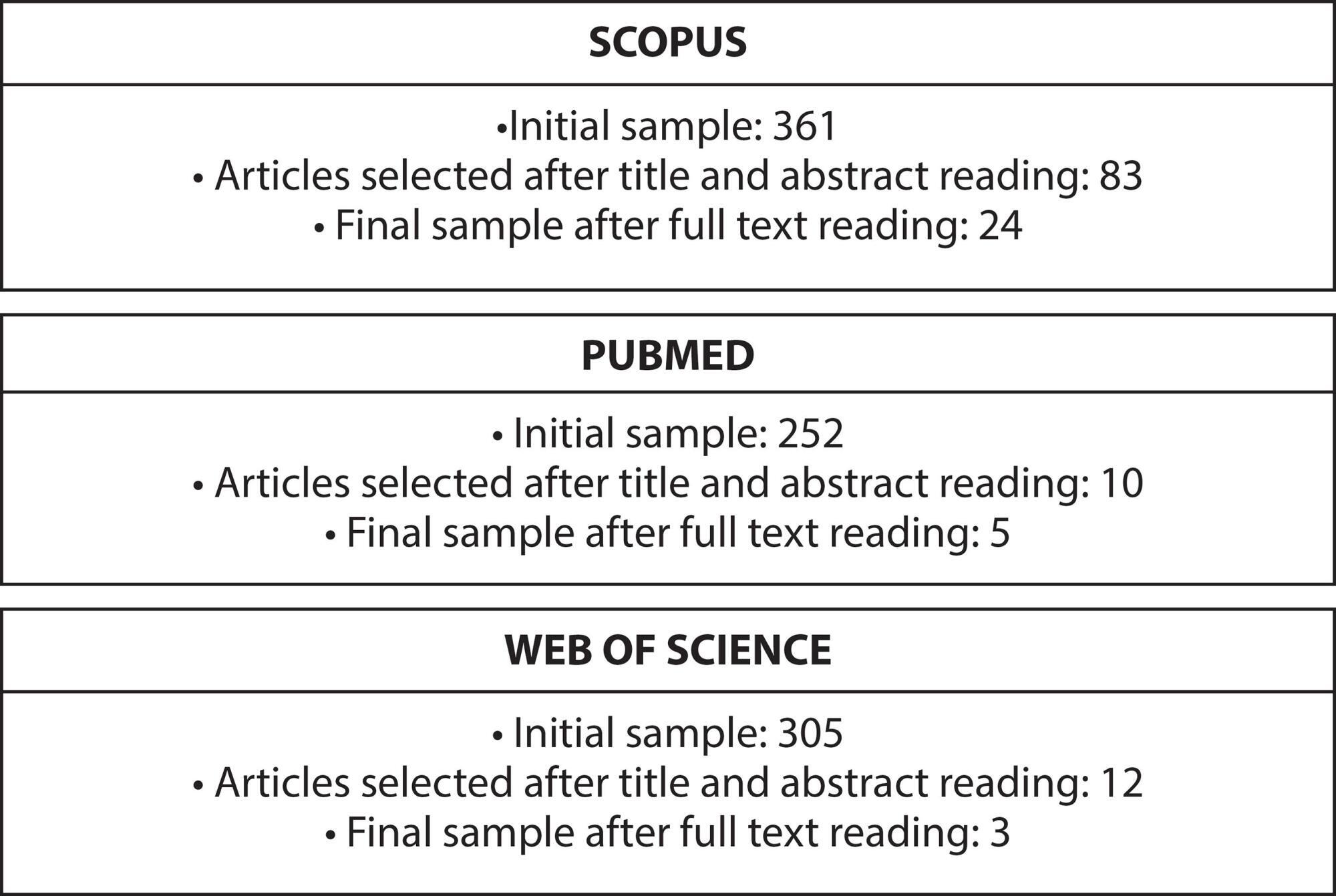
-
REFLECTION10-26-2020
New coronavirus: what does nursing have to learn and teach in times of a pandemic?
Revista Brasileira de Enfermagem. 2020;73:e20200259
Abstract
REFLECTIONNew coronavirus: what does nursing have to learn and teach in times of a pandemic?
Revista Brasileira de Enfermagem. 2020;73:e20200259
DOI 10.1590/0034-7167-2020-0259
Views0See moreABSTRACT
Objective:
To promote a theoretical reflective analysis of what nursing has to learn and teach to global society in times of OVID-19 pandemic.
Methods:
Reflective theoretical essay aimed at contributing new knowledge and raising new questions, based on the assumptions of Edgar Morin’s complexity thinking, subsidized by readings of texts extracted from electronic databases, as well as speeches by health professionals available in open communication tools.
Results:
COVID-19 reiterates that the biological warfare of the current pandemic is not fought with nuclear or fire weapons, but with care in its multiple dimensions: physical, emotional, spiritual, family, social, political and economic.
Final considerations:
Nursing has to learn and teach global society that its main object of work, care, is related to the expansion of systemic interactions and associations and the capacity to strengthen the interlocution with complex reality.
-
REVIEW12-13-2019
Critical path of women in situation of violence: an integrative literature review
Revista Brasileira de Enfermagem. 2019;72:321-332
Abstract
REVIEWCritical path of women in situation of violence: an integrative literature review
Revista Brasileira de Enfermagem. 2019;72:321-332
DOI 10.1590/0034-7167-2018-0265
Views1See moreABSTRACT
Objective:
To identify Brazilian and international scientific evidence on the critical path of women in situations of violence.
Method:
Integrative literature review developed in four databases and two electronic portals, in January 2017. Twenty-one full articles in English, Portuguese or Spanish from original researches were included in the time cut from 1994 to 2016, and which presented critical path elements, even without using this concept.
Results:
The critical path of women in situations of violence is constituted of elements related to their perceptions, actions and previous experiences regarding availability and quality of services, social representations of public servers and community and the results obtained in the search for help.
Conclusion:
Critical path elements are decisive for the women, and can promote, inhibit or delay the beginning of the route and consequently the end of situations of violence experienced by these women.
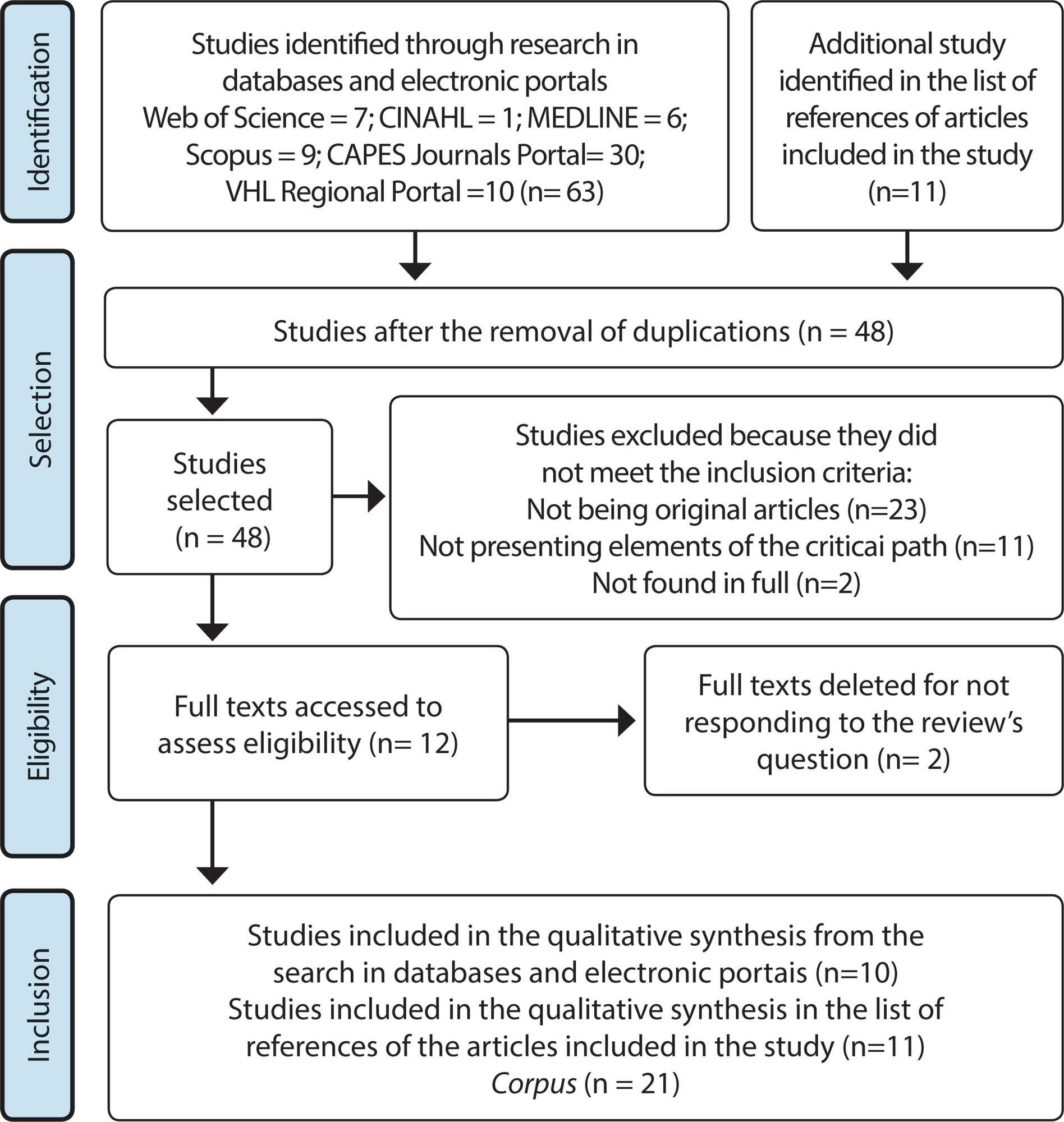
-
REVIEW08-16-2021
Fatigue due to compassion in health professionals and coping strategies: a scoping review
Revista Brasileira de Enfermagem. 2021;74(5):e20190628
Abstract
REVIEWFatigue due to compassion in health professionals and coping strategies: a scoping review
Revista Brasileira de Enfermagem. 2021;74(5):e20190628
DOI 10.1590/0034-7167-2019-0628
Views0See moreABSTRACT
Objectives:
to identify the current state of knowledge on compassion fatigue in the work context of healthcare professionals; and how coping strategies are established in this scenario.
Method:
a scoping review with search applied to the databases: MEDLINE, LILACS, CINAHL, Scopus. Temporal limit: 2009 to 2019. The data was analyzed and synthesized in narrative form
Results:
thirty articles were selected, synthesized into two categories: a) Health work and compassion fatigue: conceptual analysis, context, and manifestations; b) Coping strategies for compassion fatigue.
Conclusions:
this study presented: a descriptive and general panorama about compassion fatigue in healthcare professionals, identifying a greater consolidation of the concept between 2015 and 2018; and some coping strategies. The association between health and spirituality is highlighted as one of the strategies in this scenario, enabling new research to be conducted in view of the importance of the theme in life, health work.
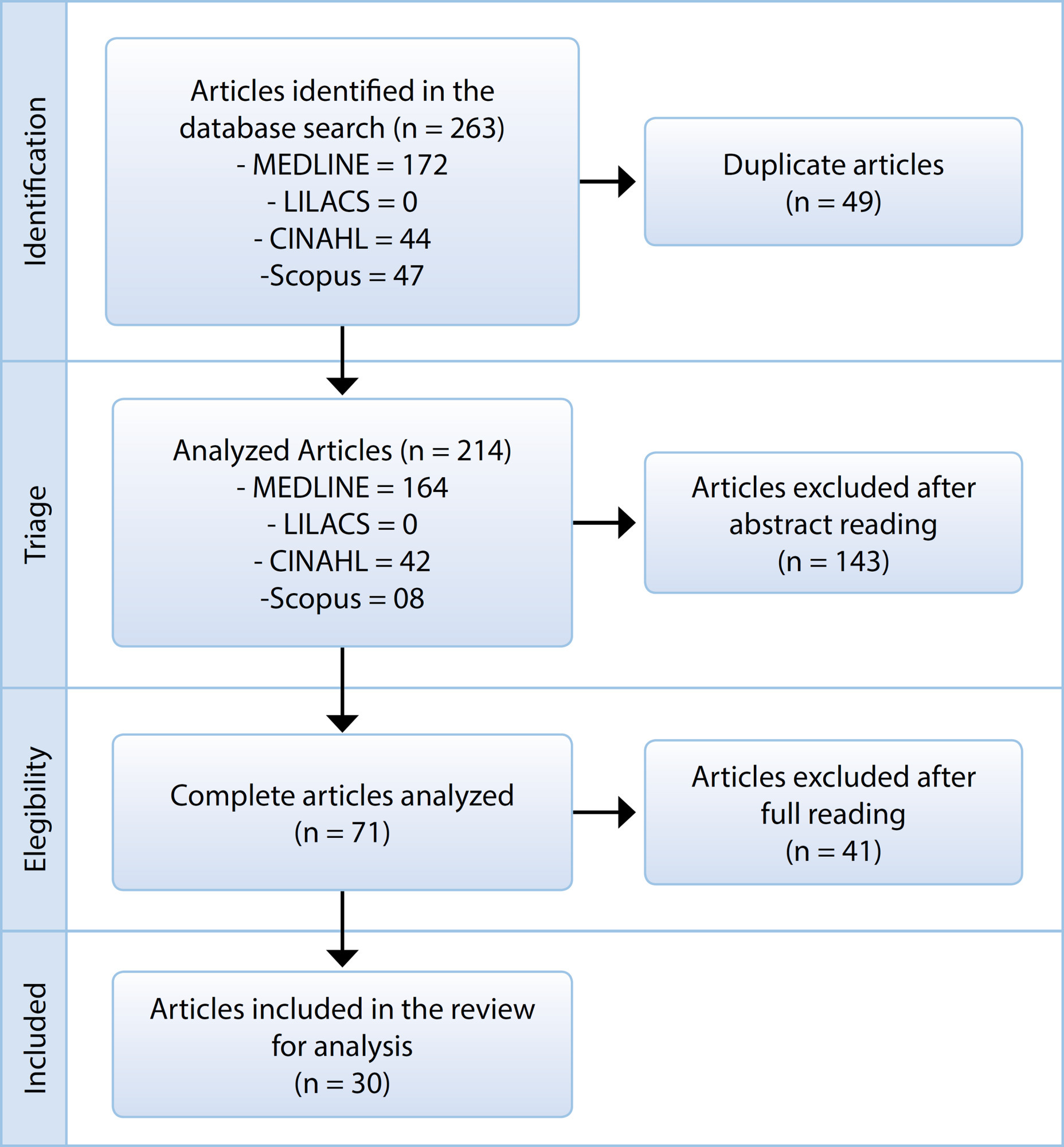
-
EXPERIENCE REPORT02-25-2022
Production and use of educational technologies in nursing post-graduation
Revista Brasileira de Enfermagem. 2022;75(5):e20210510
Abstract
EXPERIENCE REPORTProduction and use of educational technologies in nursing post-graduation
Revista Brasileira de Enfermagem. 2022;75(5):e20210510
DOI 10.1590/0034-7167-2021-0510
Views0See moreABSTRACT
Objective:
To report, under the light of Gardner’s Theory of Multiple Intelligences, the experience of students with advanced educational practices, involving the production and use of technologies in the postgraduation nursing course of the Universidade Federal de Pernambuco.
Methods:
Experience report of students from the post-graduation nursing program from the Universidade Federal de Pernambuco, about the production of knowledge using educational technology and the application of active methodologies in the teaching-learning process for face-to-face and distance teaching.
Results:
The post-graduate students participated in the educational process in a creative way, both during in-person and distance teaching. They created: domino games, educational videos, parodies, conceptual maps, virtual role-playing, an interactive quiz, among others.
Final considerations:
The experience of the students with the advanced educational practices, including the production and use of technologies in nursing post-graduation showed that the teaching-learning process can be innovative and planned to go beyond traditional methods.
-
ORIGINAL ARTICLE10-21-2019
Functional independence of elderly patients who fell: a follow-up study
Revista Brasileira de Enfermagem. 2019;72(6):1715-1722
Abstract
ORIGINAL ARTICLEFunctional independence of elderly patients who fell: a follow-up study
Revista Brasileira de Enfermagem. 2019;72(6):1715-1722
DOI 10.1590/0034-7167-2018-0845
Views0See moreABSTRACT
Objective:
to evaluate, in emergency hospital service and at home, the functional independence of elderly people who fell.
Method:
longitudinal study with 151 elderly. Functional Independence Measure (FIM) was used. Statistical tests were performed with univariate and bivariate analysis.
Results:
mean of total FIM value in the hospital was 70.4; and at home 84.3 (p <0.001). Independence was lower in the motor domain, in “self-care”, “mobility” and “locomotion” dimensions, in the two evaluations (p <0.001). Dependence reduced from 97.3% elderly in the hospital to 82.8% at home (p <0.001). There was a negative correlation between total FIM and age, number of medications, number of diseases and hospitalization time in both evaluations. Femoral and hip fractures were associated with lower total FIM values (p <0.001).
Conclusion:
the elderly had less independence in the hospital compared to at home, with greater impairment in the motor domain and “self-care”, “mobility” and “locomotion” dimensions, in the two moments evaluated.

-
ORIGINAL ARTICLE11-29-2022
Ethics in nursing: categorization of legal processes
Revista Brasileira de Enfermagem. 2022;75(3):e20210099
Abstract
ORIGINAL ARTICLEEthics in nursing: categorization of legal processes
Revista Brasileira de Enfermagem. 2022;75(3):e20210099
DOI 10.1590/0034-7167-2021-0099
Views0See moreABSTRACT
Objectives:
to categorize factual elements of ethical-disciplinary nursing lawsuits in the state of Goiás.
Methods:
cross-sectional, retrospective study, based on secondary data obtained from ethical-disciplinary lawsuits filed at the Regional Nursing Council of Goiás (Coren-Goiás) between the years 2010 and 2019.
Results:
the highest number of lawsuits filed was in 2013 and 2014, with a greater frequency in the state capital. The majority came from the Nursing Ethics Committees and ex-officio complaints. The professional with most complaints was the nursing technician, aged between 31 and 40 years old, at the beginning of their career. The most common type of complaints referred to performing attributions that were not within the nursing competences.
Conclusions:
as a highlight are the contributions of this study to professional ethics in nursing and the clear need to consolidate these skills in nurses who are in training and in the continuous education for those already in the profession.
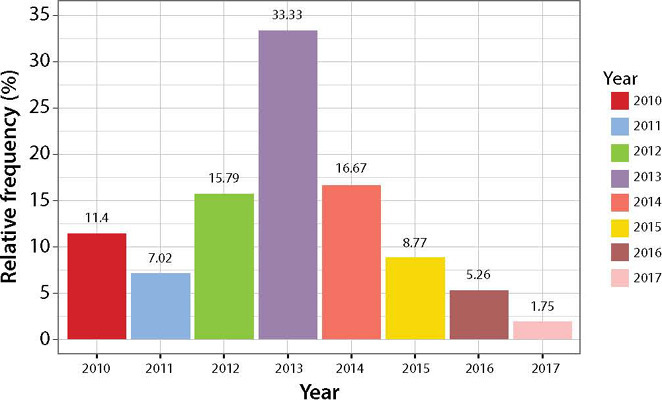
Search
Search in:
Nuvem de Tags
Adolescente (85) Atenção Primária à Saúde (239) COVID-19 (91) Criança (91) Cuidados de Enfermagem (269) Educação em Enfermagem (151) Educação em Saúde (139) Enfermagem (930) Enfermagem Pediátrica (86) Estudantes de Enfermagem (77) Estudos de Validação (131) Família (87) Idoso (208) Promoção da Saúde (99) Qualidade de Vida (104) Saúde do Trabalhador (86) Saúde Mental (145) Saúde Pública (82) Segurança do Paciente (150) Tecnologia Educacional (100)



